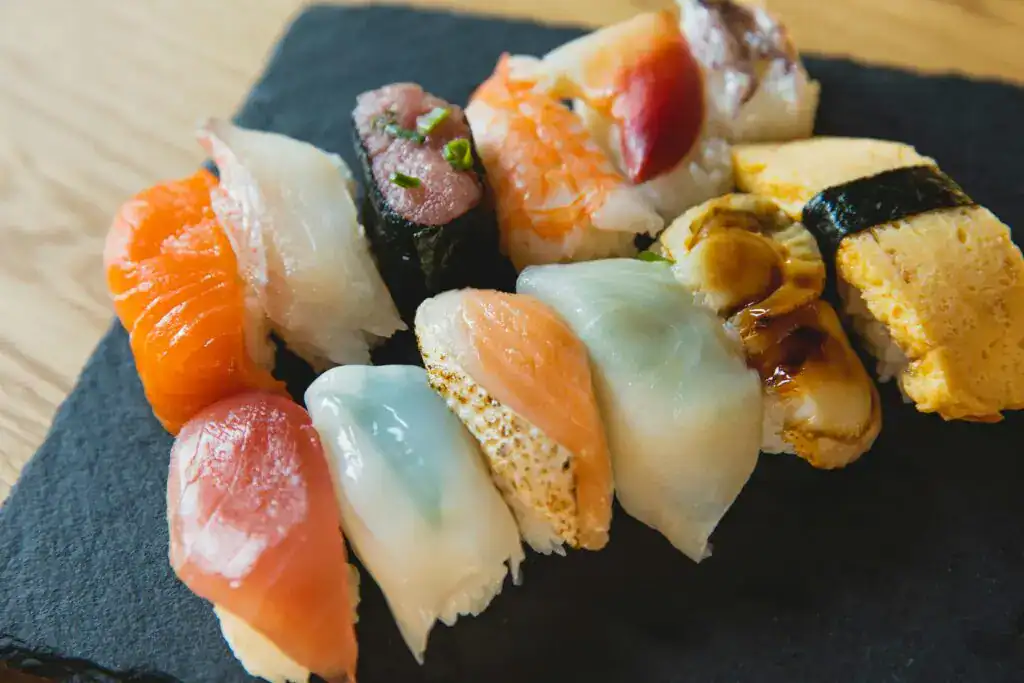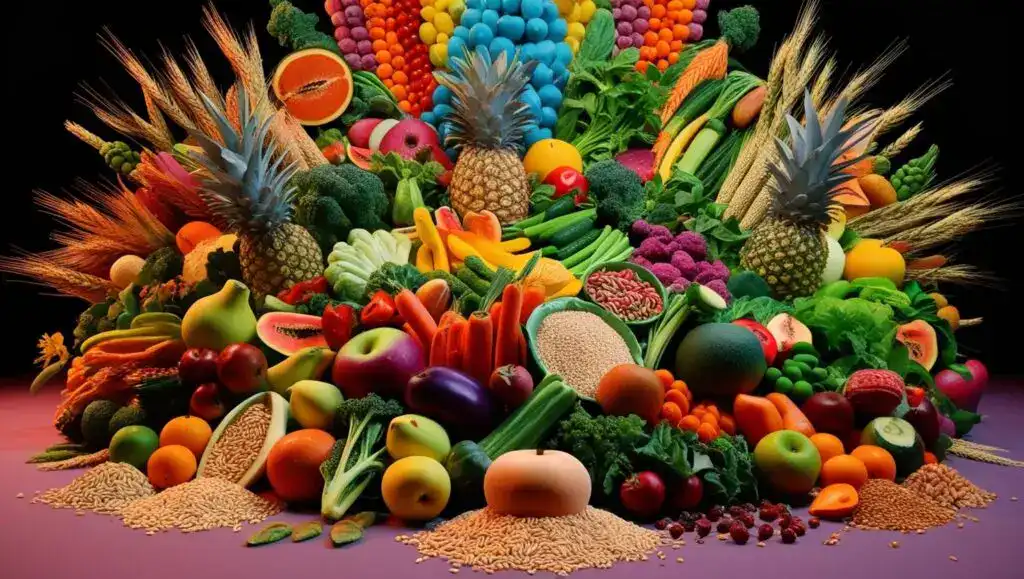How to lose weight without starving yourself with 5 Simple Steps
Lose weight without starving yourself — it’s not just possible, it’s sustainable. If you’ve been stuck in a cycle of crash diets, skipped meals, and constant hunger, you’re not alone. The truth is, you don’t need to deprive your body to shed pounds. By making smarter food choices, supporting your metabolism, and staying consistent, you can lose weight while feeling full, energized, and balanced.
Table of Contents
Toggle1. Eat More Protein to Lose Weight Without Starving Yourself
Protein is often hailed as the king of nutrients when it comes to weight management, muscle maintenance, and overall health. Whether you’re looking to shed a few pounds, build lean muscle, or simply stay energized throughout the day, increasing your protein intake can be a game-changer. Let’s dive into the science behind why protein is so effective for staying full longer, boosting metabolism, and supporting your weight loss goals.
Boost Your Protein Intake to Lose Weight Without Deprivation
Protein is a macronutrient that plays a critical role in keeping you full and satisfied. Here’s how it works:
Increases Satiety Hormones: Protein stimulates the release of hormones like peptide YY (PYY) and glucagon-like peptide-1 (GLP-1), which signal to your brain that you’re full. This helps reduce hunger and prevents overeating.
Reduces Ghrelin Levels: Protein lowers levels of ghrelin, the “hunger hormone,” which is responsible for stimulating appetite. By keeping ghrelin in check, protein helps you feel fuller for longer.
Slows Digestion: Protein takes longer to digest than carbohydrates or fats, which means it stays in your stomach longer and keeps you satisfied between meals.
How Protein Helps You Feel Full and Lose Weight the Healthy Way
In addition to keeping you full, protein has a unique ability to boost your metabolism and increase calorie burn. Here’s why:
High Thermic Effect of Food (TEF): Protein has a higher thermic effect compared to fats and carbohydrates, meaning your body burns more calories digesting and processing it. In fact, about 20–30% of the calories from protein are used during digestion, compared to 5–10% for carbs and 0–3% for fats.
Supports Muscle Mass: Protein is essential for maintaining and building lean muscle mass, especially during weight loss. Muscle tissue is metabolically active, meaning it burns more calories at rest than fat tissue. By preserving muscle, protein helps keep your metabolism running efficiently.
Lose Weight the Smart Way: Why Protein Keeps You Satisfied
One of the biggest challenges of weight loss is managing cravings and sticking to a calorie deficit. Protein can help with that too:
Curbs Sugar Cravings: Studies show that a high-protein diet can reduce cravings for sugary and high-calorie foods. This is likely due to protein’s ability to stabilize blood sugar levels and keep hunger hormones in check.
Promotes Fat Loss: A high-protein diet has been shown to increase fat loss while preserving lean muscle mass. This is especially important for maintaining a healthy metabolism and achieving a toned physique.
Improves Adherence to Diets: Because protein keeps you full and satisfied, it’s easier to stick to a calorie-controlled diet without feeling deprived.


Eat Protein to Lose Weight Without Cutting Calories Too Low
Increasing your protein intake doesn’t have to be complicated. Here are some simple and delicious ways to add more protein to your meals and snacks:
Start Your Day with Protein: Include protein-rich foods like eggs, Greek yogurt, or a protein smoothie in your breakfast to kickstart your metabolism and stay full until lunch.
Snack on High-Protein Foods: Choose snacks like hard-boiled eggs, cottage cheese, nuts, or protein bars to keep hunger at bay between meals.
Add Protein to Every Meal: Include a source of lean protein (like chicken, fish, tofu, or beans) in every meal to ensure you’re meeting your daily protein needs.
Experiment with Plant-Based Proteins: If you’re vegetarian or vegan, opt for plant-based protein sources like lentils, chickpeas, quinoa, and tempeh.
Use Protein Supplements: Protein powders (like whey, pea, or hemp protein) can be a convenient way to boost your intake, especially after workouts or when you’re on the go.
Pro Tip: If you struggle to meet your protein needs, try a protein powder. It’s an easy way to add protein to smoothies, oatmeal, or baked goods.
Supplement Suggestion: A collagen supplement can also support your protein intake while promoting healthy skin, hair, and joints.
2. Fiber for Weight Loss
Fiber is one of the most underrated yet essential nutrients for weight management and overall health. Found in plant-based foods like vegetables, fruits, whole grains, and legumes, fiber plays a crucial role in keeping you full, stabilizing blood sugar levels, and promoting a healthy digestive system. Let’s explore the science behind why fiber-rich foods are so effective for weight loss and how you can easily incorporate them into your diet. A 2022 article by Mayo Clinic explains that a diet high in fiber not only helps you feel full but also plays a key role in stabilizing blood sugar and promoting digestive health. This makes fiber a powerful ally for anyone trying to lose weight without feeling deprived.
Use Fiber to Lose Weight Naturally Without Starving Yourself
Fiber is a type of carbohydrate that your body can’t digest. Instead, it passes through your digestive system relatively intact, providing a range of health benefits. Here’s how fiber helps you stay full and supports weight loss:
Slows Digestion: Soluble fiber, found in foods like oats, beans, and apples, dissolves in water to form a gel-like substance in your stomach. This slows down digestion, helping you feel full for longer and reducing the likelihood of overeating.
Adds Bulk to Meals: Insoluble fiber, found in foods like whole grains, nuts, and vegetables, adds bulk to your meals without adding calories. This helps you feel satisfied while consuming fewer calories overall.
Reduces Hunger Hormones: Fiber-rich foods can lower levels of ghrelin, the hunger hormone, and increase levels of peptide YY (PYY), a hormone that promotes feelings of fullness.
How Fiber Keeps You Full and Helps You Lose Weight Without Deprivation
One of the key benefits of fiber is its ability to regulate blood sugar levels, which is especially important for weight management and overall health. Here’s how it works:
Slows Sugar Absorption: Soluble fiber slows the absorption of sugar into your bloodstream, preventing blood sugar spikes and crashes. This helps maintain steady energy levels and reduces cravings for sugary snacks.
Improves Insulin Sensitivity: A high-fiber diet has been shown to improve insulin sensitivity, which helps your body use glucose more effectively and reduces the risk of type 2 diabetes.
Lose Weight Without Feeling Hungry by Eating Fiber-Rich Foods
In addition to keeping you full and stabilizing blood sugar, fiber is essential for maintaining a healthy digestive system. Here’s why:
Promotes Regularity: Insoluble fiber adds bulk to your stool and helps it move through your digestive tract more efficiently, preventing constipation and promoting regular bowel movements.
Feeds Gut Bacteria: Soluble fiber acts as a prebiotic, feeding the beneficial bacteria in your gut. A healthy gut microbiome is linked to improved digestion, better nutrient absorption, and even enhanced immune function.
Fiber-Rich Foods Are Low in Calories
One of the best things about fiber-rich foods is that they are typically low in calories but high in volume. This means you can eat larger portions without consuming too many calories, making them perfect for weight loss. For example:
A cup of broccoli has only 55 calories but provides 5 grams of fiber.
A medium apple has about 95 calories and 4 grams of fiber.
A half-cup of cooked lentils has 115 calories and 8 grams of fiber.


How to Incorporate More Fiber into Your Diet
Adding more fiber to your diet is easier than you might think. Here are some simple and delicious ways to boost your fiber intake:
Start Your Day with Whole Grains: Choose fiber-rich breakfast options like oatmeal, whole-grain cereal, or whole-wheat toast.
Snack on Fruits and Vegetables: Keep fresh fruits and veggies on hand for easy, fiber-packed snacks. Apples, carrots, and celery sticks are great options.
Add Legumes to Your Meals: Incorporate beans, lentils, and chickpeas into soups, salads, and main dishes for a fiber and protein boost.
Choose Whole Grains: Swap refined grains (like white rice and pasta) for whole grains (like brown rice, quinoa, and whole-wheat pasta).
Experiment with Seeds and Nuts: Add chia seeds, flaxseeds, or almonds to your yogurt, smoothies, or salads for extra fiber and healthy fats.
Pro Tip: If you’re not getting enough fiber, try a fiber supplement. It’s an easy way to support digestion and curb hunger.
Supplement Suggestion: A greens powder can also help you increase your veggie intake effortlessly.
3. Drink Water Before Meals to Lose Weight Without Starving Yourself
Drinking water before meals is a simple, natural, and highly effective strategy for supporting weight loss and improving overall health. This easy habit can help you eat less, feel fuller, and achieve your weight management goals without drastic diet changes or expensive supplements. Let’s explore the science behind why drinking water before meals works, how it supports weight loss, and how you can incorporate this practice into your daily routine for optimal results.
Lose Weight Without Feeling Hungry: Drink Water Before Meals
Water is essential for life, but it also plays a surprising role in appetite control and weight management. Here’s how drinking water before meals can help you eat less and lose weight naturally:
Creates a Sense of Fullness: Drinking water before a meal takes up space in your stomach, creating a sense of fullness. This can help you eat smaller portions and reduce overall calorie intake, making it easier to maintain a calorie deficit for weight loss.
Reduces Hunger and Cravings: Sometimes, thirst is mistaken for hunger. By drinking water before meals, you can ensure that you’re properly hydrated and avoid unnecessary snacking or overeating.
Boosts Metabolism: Drinking water, especially cold water, can temporarily increase your metabolism. Your body uses energy to heat the water to body temperature, which can slightly boost calorie burn over time.
Supports Digestion and Nutrient Absorption: Water helps break down food and aids in the absorption of nutrients. Drinking water before meals can improve digestion and help you recognize when you’re truly full, preventing overeating.
Hydration Hacks to Curb Hunger and Support Healthy Weight Loss
Research supports the idea that drinking water before meals can significantly aid in weight loss. One notable study found that:
Participants who drank 500 ml (about 2 cups) of water before meals lost 44% more weight over 12 weeks compared to those who didn’t.
Drinking water before meals also led to a reduction in calorie intake, as participants felt fuller and ate smaller portions.
This study highlights how a simple, natural habit like drinking water before meals can have a profound impact on weight loss efforts.
Use Water to Feel Fuller and Lose Weight Without Extreme Diets
Here’s a breakdown of how this strategy works to support weight loss naturally:
Reduces Calorie Intake: By creating a sense of fullness, water helps you eat fewer calories during meals, making it easier to maintain a calorie deficit.
Prevents Overeating: Staying hydrated can help you distinguish between hunger and thirst, reducing the likelihood of overeating or reaching for unhealthy snacks.
Encourages Mindful Eating: Drinking water before meals can serve as a mindful eating practice, helping you slow down and pay attention to your body’s hunger cues.


How Drinking Water Before Meals Aids in Hunger-Free Weight Loss
Adding this simple practice to your daily routine is easy and requires no special tools or preparation. Here’s how to get started:
Drink Water 30 Minutes Before Meals: Aim to drink 1–2 cups of water about 30 minutes before each meal. This gives your body time to register the fullness signal and prepare for digestion.
Start Your Day with Water: Drink a glass of water first thing in the morning to kickstart your metabolism, rehydrate after sleep, and set a positive tone for the day.
Carry a Reusable Water Bottle: Keep a reusable water bottle with you throughout the day to stay hydrated and remind yourself to drink water before meals.
Flavor Your Water (Optional): If plain water feels boring, add a slice of lemon, cucumber, or a few mint leaves for a refreshing twist that makes hydration more enjoyable.
Set Reminders: Use phone alarms or sticky notes to remind yourself to drink water before meals until it becomes a habit.
Pro Tip: If you struggle to drink enough water, try a fruit-infuser water bottle. It makes staying hydrated fun and refreshing.
Supplement Suggestion: An electrolyte supplement can help you stay hydrated, especially after workouts.
4. Mindful Eating for Weight Loss
Mindful eating is a powerful practice that can transform your relationship with food, help you tune into your body’s natural hunger and fullness cues, and support your weight loss goals. Unlike restrictive diets, mindful eating focuses on being present during meals, savoring each bite, and listening to your body’s signals. Let’s explore the science behind mindful eating, how it prevents overeating, and how you can incorporate this practice into your daily life for lasting results.
Mindful Eating: How to Lose Weight Without Starving Yourself
Mindful eating is rooted in mindfulness, a practice that involves paying attention to the present moment without judgment. When applied to eating, it helps you become more aware of your food choices, eating habits, and body signals. Here’s how it works:
Prevents Overeating: By slowing down and paying attention to your body’s hunger and fullness cues, mindful eating helps you recognize when you’re truly hungry and when you’ve had enough. This reduces the likelihood of overeating or eating out of boredom or stress.
Enhances Satisfaction: Mindful eating encourages you to savor each bite, which can make meals more enjoyable and satisfying. When you truly enjoy your food, you’re less likely to feel deprived or crave unhealthy snacks.
Reduces Emotional Eating: Many people turn to food for comfort during times of stress, sadness, or boredom. Mindful eating helps you become more aware of these emotional triggers and develop healthier coping mechanisms.
Improves Digestion: Eating slowly and chewing thoroughly, which are key components of mindful eating, can improve digestion and nutrient absorption.
Scientific Evidence: Mindful Eating and Weight Loss
Research supports the effectiveness of mindful eating for weight management:
A study published in the Journal of Obesity found that participants who practiced mindful eating experienced significant reductions in binge eating, emotional eating, and weight.
Another study in the American Journal of Clinical Nutrition showed that mindful eating can lead to better portion control and a healthier relationship with food.
These studies highlight how mindful eating can help you make better food choices, reduce overeating, and support long-term weight loss.
How Mindful Eating Helps You Lose Weight Without Starving Yourself
Here’s a breakdown of how mindful eating can help you achieve your weight loss goals:
Tune Into Hunger and Fullness Cues: Mindful eating helps you recognize when you’re truly hungry and when you’re full, preventing overeating and unnecessary snacking.
Slow Down and Enjoy Your Food: Eating slowly allows your brain to register when you’re satisfied, which can help you eat less and feel more satisfied.
Reduce Emotional Eating: By becoming more aware of your emotions and how they influence your eating habits, you can break the cycle of emotional eating.
Make Healthier Food Choices: Mindful eating encourages you to choose foods that nourish your body and make you feel good, rather than reaching for unhealthy options out of habit or cravings.


How to Practice Mindful Eating
Incorporating mindful eating into your daily routine is simple and doesn’t require any special tools or equipment. Here’s how to get started:
Eat Without Distractions: Turn off the TV, put away your phone, and focus solely on your meal. This helps you pay attention to the taste, texture, and aroma of your food.
Slow Down: Take smaller bites, chew thoroughly, and put your fork down between bites. This gives your brain time to register when you’re full.
Listen to Your Body: Before eating, ask yourself if you’re truly hungry. During the meal, check in with yourself to see if you’re still hungry or if you’re eating out of habit or boredom.
Savor Each Bite: Pay attention to the flavors, textures, and smells of your food. Notice how each bite makes you feel and appreciate the experience of eating.
Practice Gratitude: Take a moment before eating to appreciate your food and the effort that went into preparing it. This can help you develop a healthier relationship with food.
Stop When You’re Full: Learn to recognize when you’re satisfied, not stuffed. It’s okay to leave food on your plate if you’ve had enough.
Pro Tip: If you’re new to mindful eating, try a guided mindfulness app. These apps can help you develop healthier eating habits.
Supplement Suggestion: A craving control supplement can also help you stay on track by reducing sugar cravings.
Get Moving in Fun Ways to Lose Weight Without Starving Yourself
When it comes to weight loss, exercise doesn’t have to mean long, exhausting hours in a gym. In fact, incorporating activities you actually enjoy can make staying active a lot easier and more effective. Whether you’re walking in nature, dancing, or playing a sport, these enjoyable activities can help you burn calories and improve your overall health—without the stress of a traditional workout routine.
The key is to find activities that feel fun and engaging, so they don’t feel like “exercise.” You’re more likely to stick with them over time, which makes staying active a natural part of your daily life. Plus, having fun while moving can significantly boost your energy levels and mood.
Burn Calories Without the Hunger: Fun Ways to Stay Active
1. Dance Your Way to Fitness
Dancing is a wonderful full-body workout that you can do anywhere, whether in a class, at a party, or even just in your living room. Dance keeps your body moving in an exciting way, increasing your heart rate while toning your muscles. And because it’s so enjoyable, it doesn’t feel like exercise at all—making it a fantastic way to stay active without a gym.
2. Explore the Outdoors Through Hiking and Walking
Hiking is an excellent activity that offers both a mental and physical escape. Whether you’re hiking a mountain trail or simply taking a walk around your neighborhood, these activities help improve cardiovascular health, increase endurance, and burn calories. Walking outside also allows you to connect with nature and clear your mind, making it a fun, relaxing way to get active.
3. Make a Splash with Swimming
If you’re looking for a low-impact activity that gives you a full-body workout, swimming is perfect. The water provides natural resistance, working all your muscles while you burn calories. Whether you’re doing laps in a pool or swimming at the beach, it’s an exciting and refreshing way to stay in shape. Plus, swimming is gentle on the joints, making it accessible for people of all fitness levels.
4. Get Competitive with Sports and Recreational Games
Playing sports like tennis, basketball, or even a casual game of soccer is a great way to stay fit and have fun. These activities keep you moving, improve coordination, and help you burn calories—all while you’re enjoying yourself. Engaging in friendly competition can also keep you motivated and excited about staying active.
5. Stay Playful with Kids or Pets
If you have children or pets, you already have the perfect workout partners. Running around with your kids or taking your dog for a walk can provide excellent cardiovascular benefits. Activities like playing tag or fetch not only help burn calories but also allow you to spend quality time with loved ones. This makes staying active feel less like a chore and more like a bonding experience.


Why Fun Movement Works:
Set Enjoyable Goals:
Instead of focusing on a specific weight or measurement, set goals that focus on having fun—like dancing every day for 30 minutes or exploring a new trail each weekend. This way, the goal feels more like an adventure and less like a task.Try New Things:
Keep things fresh by exploring different activities. Try a new sport, take a dance class, or find a new hiking spot. The variety will keep you excited and engaged.Include Others:
Make your chosen activities a social event. Invite friends or family to join in. Whether it’s a weekend hike or a dance-off at home, having others involved can boost motivation and make it even more enjoyable.
Pro Tip: If you need inspiration, try a fitness tracker. It can motivate you to stay active by tracking your steps and calories burned.
Supplement Suggestion: A post-workout recovery supplement can help your muscles recover faster and reduce soreness.
Product Recommendations
Here are some of my top picks to help you lose weight effortlessly:
- Protein Powder: Perfect for boosting your protein intake.
- Fiber Supplement: Supports digestion and keeps you full.
- Fruit-Infuser Water Bottle: Makes staying hydrated fun and easy.
- Guided Mindfulness App: Helps you develop mindful eating habits.
- Fitness Tracker: Motivates you to stay active.
- Post-Workout Recovery Supplement: Speeds up muscle recovery.
Conclusion
Losing weight doesn’t have to involve starvation or extreme measures. By focusing on protein, fiber, hydration, mindful eating, and enjoyable movement, you can achieve your goals effortlessly. Remember, small, consistent changes lead to lasting results. Start today and enjoy the journey!
FAQs
1. What are the best ways to lose weight without feeling hungry all the time?
Losing weight without hunger is possible by focusing on protein-rich foods, fiber, and healthy fats. These nutrients keep you full longer and help reduce cravings naturally. Drinking water before meals, practicing mindful eating, and choosing nutrient-dense foods also help control appetite while promoting weight loss.
2. How can I lose weight without giving up my favorite foods?
Instead of eliminating your favorite foods, focus on portion control and healthier swaps. Enjoy balanced meals with lean protein, whole grains, and vegetables while allowing yourself occasional treats in moderation. Mindful eating can help you savor every bite and avoid overeating, making weight loss more sustainable.
3. Can I lose weight without going to the gym or doing intense workouts?
Yes! You can lose weight by incorporating fun physical activities into your daily routine, such as walking, dancing, hiking, or swimming. Even small movements, like taking the stairs or stretching at home, contribute to calorie burning. Consistency is key to seeing results without traditional workouts.
4. What is the best way to stop emotional eating and unhealthy cravings?
Mindful eating, stress management, and balanced nutrition can help reduce emotional eating. Keeping healthy snacks available, practicing relaxation techniques like yoga or meditation, and identifying emotional triggers can help you break the cycle of stress eating and make healthier choices.
5. How can I speed up my metabolism naturally to lose weight more easily?
Boosting metabolism naturally involves eating enough protein, drinking plenty of water, staying active, and getting quality sleep. Strength training, high-fiber foods, and certain supplements like green tea extract or protein powders can also support a faster metabolism and promote fat loss.
Disclaimer
Some of the links in this post are affiliate links, which means I may earn a small commission if you purchase through them. This comes at no extra cost to you and helps support the creation of free, valuable content like this. Thank you for your support!
